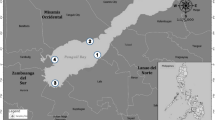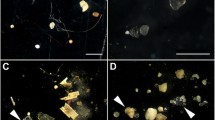Abstract.
The community structure of a benthic macroinvertebrate assemblage in a contaminated salt marsh was evaluated as part of an ecological characterization of a former chloralkali production facility in Georgia. Sample locations were chosen based on a gradient of the primary contaminants of concern, total mercury and polychlorinated biphenyls (PCBs), primarily Aroclor 1268. Sediment concentrations of Aroclor 1268 ranged from 2.3 to 150 mg/kg dry weight, while mercury concentrations ranged from 15 to 170 mg/kg dry weight in the study area. Mercury and PCBs were determined to be co-located in the sediments. Total organic carbon composition of the sediments was negatively associated with PCB and mercury concentrations. A total of 29 benthic taxa was identified in 49 samples; replicate samples were taken at each of five sampling locations. Mean infaunal density across all sampling locations was estimated at approximately 61,000 to 234,000 organisms m−2. Overall, polychaetes comprised 57% of the infaunal community with Manayunkia aestuarina as the dominant species. Oligochaetes, nematodes, crustacea, insects, and gastropods comprised 23.0, 18.0, 1.0, 0.7, and 0.2% of the overall benthic community, respectively. Density estimates of individual species between sampling locations showed no consistent patterns in response to pollutants. However, an analysis of higher taxonomic levels revealed some general trends. In uncontaminated areas, the benthic community was dominated by nematodes and oligochaetes, whereas moderate to highly contaminated areas were dominated by polychaetes and a smaller percentage of oligochaetes and nematodes. A trophic analysis of the same data set revealed that the community shifted from an evenly distributed percentage of surface and subsurface feeders in the uncontaminated areas to a community dominated by surface feeders in the more contaminated locations. Carnivores comprised from 0.13 to 0.90% of the trophic structure, with the percentage of carnivores generally decreasing with increasing contamination. Mercury and PCBs were bioaccumulating in representative marsh benthic invertebrates, presenting a potential source of contaminants to marsh consumers. Tissue PCB and tissue mercury concentrations were positively related to sediment PCB and mercury concentrations, respectively. A standard 14-day toxicity test using the amphipod Leptocheirus plumulosus showed no acute toxicity across the sampling locations.
Similar content being viewed by others
Author information
Authors and Affiliations
Additional information
Received: 29 October 1998/Accepted: 3 May 1999
Rights and permissions
About this article
Cite this article
Horne, M., Finley, N. & Sprenger, M. Polychlorinated Biphenyl- and Mercury-Associated Alterations on Benthic Invertebrate Community Structure in a Contaminated Salt Marsh in Southeast Georgia. Arch. Environ. Contam. Toxicol. 37, 317–325 (1999). https://doi.org/10.1007/s002449900520
Issue Date:
DOI: https://doi.org/10.1007/s002449900520




